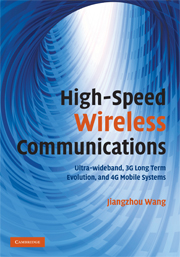1 - Introduction to high-speed wireless communications
from Part I - Introduction
Published online by Cambridge University Press: 27 May 2010
Summary
Wireless communications and internet services have been penetrating into our society and affecting our everyday life profoundly during the last decade far beyond any earlier expectations. In addition, the demand for wireless communications is still growing rapidly and wireless systems that support voice communications have already been deployed with great success. Further wireless mobile and personal communication systems are expected to support a variety of high-speed multimedia services, such as high-speed internet access, high-quality video transmission and so on. To meet the demand for high data rate services in broadband wireless systems, various systems and/or technologies have been proposed, such as the ultra-wideband (UWB) system, and evolved third generation (3G) and fourth generation (4G) mobile communications systems.
UWB communications
In the foreseeable future, the development of low-power, short-range and high-speed transmission systems is going to play a significant role in the area of wireless communication, due to a blooming growth in demand for information sharing and data distribution tools to be used in hot-spot layer and personal network layer communications. At the same time, the radio frequency (RF) spectrum suitable for wireless links is limited, so efficient spectrum utilization is a challenging problem in physical-layer communication engineering [1]. All these have motivated the exploration of the UWB transmission system.
Recently, there has been a growing interest in the research and development of novel technologies aimed at allowing new services to use the radio spectrum already allocated to established services, but without causing noticeable interference to existing users.
- Type
- Chapter
- Information
- High-Speed Wireless CommunicationsUltra-wideband, 3G Long Term Evolution, and 4G Mobile Systems, pp. 3 - 30Publisher: Cambridge University PressPrint publication year: 2008



